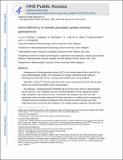| dc.contributor.author | Cosyns, S. M. R. | |
| dc.contributor.author | Dhaese, I. | |
| dc.contributor.author | Thoonen, Robrecht | |
| dc.contributor.author | Buys, Emmanuel | |
| dc.contributor.author | Vral, A. | |
| dc.contributor.author | Brouckaert, P. | |
| dc.contributor.author | Lefebvre, R. A. | |
| dc.date.accessioned | 2016-12-21T19:33:57Z | |
| dc.date.issued | 2013 | |
| dc.identifier.citation | Cosyns, S. M. R., I. Dhaese, R. Thoonen, E. S. Buys, A. Vral, P. Brouckaert, and R. A. Lefebvre. 2013. Heme Deficiency of Soluble Guanylate Cyclase Induces Gastroparesis. Neurogastroenterology & Motility 25, no. 5: e339–e352. doi:10.1111/nmo.12120. . | en_US |
| dc.identifier.issn | 1350-1925 | en_US |
| dc.identifier.uri | http://nrs.harvard.edu/urn-3:HUL.InstRepos:29731919 | |
| dc.description.abstract | Background: Soluble guanylate cyclase (sGC) is the principal target of nitric oxide (NO) to control gastrointestinal motility. The consequence on nitrergic signaling and gut motility of inducing a heme-free status of sGC, as induced by oxidative stress, was investigated. Methods: sGCβ1H105F knock-in (apo-sGC) mice, which express heme-free sGC that has basal activity, but cannot be stimulated by NO, were generated. Key Results: Diethylenetriamine NONOate did not increase sGC activity in gastrointestinal tissue of apo-sGC mice. Exogenous NO did not induce relaxation in fundic, jejunal and colonic strips, and pyloric rings of apo-sGC mice. The stomach was enlarged in apo-sGC mice with hypertrophy of the muscularis externa of the fundus and pylorus. In addition, gastric emptying and intestinal transit were delayed and whole-gut transit time was increased in the apo-sGC mice, while distal colonic transit time was maintained. The nitrergic relaxant responses to electrical field stimulation at 1–4 Hz were abolished in fundic and jejunal strips from apo-sGC mice, but in pyloric rings and colonic strips, only the response at 1 Hz was abolished, indicating the contribution of other transmitters than NO. Conclusions & Inferences: The results indicate that the gastrointestinal consequences of switching from a native sGC to a heme-free sGC, which cannot be stimulated by NO, are most pronounced at the level of the stomach establishing a pivotal role of the activation of sGC by NO in normal gastric functioning. In addition, delayed intestinal transit was observed, indicating that nitrergic activation of sGC also plays a role in the lower gastrointestinal tract. | en_US |
| dc.language.iso | en_US | en_US |
| dc.publisher | Wiley-Blackwell | en_US |
| dc.relation.isversionof | doi:10.1111/nmo.12120 | en_US |
| dc.relation.hasversion | https://www.ncbi.nlm.nih.gov/pmc/articles/PMC4932850/ | en_US |
| dash.license | LAA | |
| dc.subject | gastrointestinal motility | en_US |
| dc.subject | nitric oxide | en_US |
| dc.subject | soluble guanylate cyclase | en_US |
| dc.title | Heme deficiency of soluble guanylate cyclase induces gastroparesis | en_US |
| dc.type | Journal Article | en_US |
| dc.description.version | Accepted Manuscript | en_US |
| dc.relation.journal | Neurogastroenterology & Motility | en_US |
| dash.depositing.author | Buys, Emmanuel | |
| dc.date.available | 2016-12-21T19:33:57Z | |
| dc.identifier.doi | 10.1111/nmo.12120 | * |
| dash.contributor.affiliated | Thoonen, Robrecht | |
| dash.contributor.affiliated | Buys, Emmanuel | |


